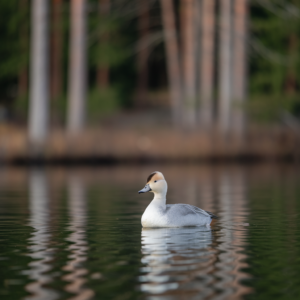White birds are captivating creatures known for their elegance and distinctive appearances. From majestic swans to elusive snowy owls, these birds inhabit diverse environments worldwide and contribute to their ecosystems in unique ways. This article explores the fascinating world of white birds, detailing their characteristics, habitats, and ecological significance.
Introduction to White Birds

White birds stand out in the avian world with their stunning plumage and graceful flight. They are found across various habitats, from marshes and wetlands to the cold expanses of the Arctic tundra. Their striking white feathers often serve as camouflage to attract mates or help regulate body temperature.
The diversity of these birds highlights their adaptability and importance in nature. They can be found in nearly every corner of the globe, playing critical roles in their ecosystems. Check out the Cornell Lab of Ornithology for more insights into their habitats and behaviors.
Types of White Birds
There are many species of white birds, each with its own set of unique traits and ecological roles. Below is an overview of some of the most notable white bird species:
1. Great Egret

The Great Egret is a tall, long-necked bird often seen wading gracefully in shallow waters. It hunts by standing still or slowly stalking its prey, striking with lightning speed to catch fish, amphibians, and insects.
- Habitat: Wetlands, marshes, and coastal regions.
- Distinctive Features: Long neck and legs, sharp yellow bill.
- Conservation Status: Least Concern, though protected in many areas to prevent habitat loss.
2. White Ibis

The White Ibis is easily recognized by its bright red legs and curved bill, which it uses to probe for insects and small aquatic creatures. This bird is often seen in large flocks, adding a splash of white to marshy landscapes.
- Habitat: Wetlands, coastal areas, and swamps.
- Diet: Insects, small fish, and crustaceans.
- Ecological Role: Helps maintain insect populations, contributing to the health of wetland ecosystems.
3. Tundra Swan

Known for their soft, melodic calls, Tundra Swans migrate long distances between their Arctic breeding grounds and wintering sites in coastal regions. They are social birds, often seen flying in V-formations.
- Habitat: Arctic tundras and coastal waters during winter.
- Migration Patterns: Long-distance migration, roosts in open waters at night.
- Importance: Grazing helps manage vegetation in Arctic and subarctic ecosystems.
For additional information on avian habitats and conservation efforts, visit the Audubon Society.
4. Trumpeter Swan
The Trumpeter Swan is the most enormous North American swan, notable for its loud, trumpet-like call. These majestic birds were once nearly extinct but have remarkably recovered thanks to extensive conservation efforts.
- Habitat: Lakes, rivers, and marshes.
- Behavior: Graceful swimmers with distinctive vocalizations.
- Conservation Status: A conservation success story, now commonly seen in protected areas.
5. Snowy Owl

The Snowy Owl is an iconic Arctic bird known for its bright white plumage and piercing yellow eyes. These owls are mighty hunters who feed on lemmings and other small mammals.
- Habitat: Arctic tundra and open fields during migration.
- Diet: Small mammals and birds are occasionally seen hunting during the day.
- Cultural Significance: Featured prominently in folklore and popular media as a symbol of wisdom and mystery.
6. American White Pelican

The American White Pelican is a large bird with a broad wingspan and distinct feeding habits. It often hunts in groups, corralling fish into shallow waters where it can easily scoop them up with its large bills.
- Physical Characteristics: Large body, long wings, and distinctive bill.
- Feeding Behavior: Cooperative hunting strategies.
- Preferred Habitats: Lakes, marshes, and coastal waters.
7. Smew

The Smew is a small, striking duck found primarily in Europe and Asia. Males are distinguished by their unique black and white “panda-like” markings, while females and juveniles are predominantly grey.
- Size: Small and agile, notable for its striking sexual dimorphism.
- Habitat: Freshwater lakes, rivers, and pools.
- Conservation Status: Least Concern, widespread across its range.
Ecological Importance and Symbolism of White Birds
White birds are visually stunning and play crucial roles in their ecosystems. They act as predators, scavengers, and ecological indicators, helping to maintain the balance of nature.
Ecological Roles of White Birds
- Predators and Scavengers: Species like the Great Egret and White Ibis control fish and insect populations, contributing to healthy aquatic ecosystems.
- Ecosystem Maintenance: Swans and pelicans manage vegetation and prey populations, ensuring ecological balance.
Symbolism and Cultural Significance
White birds are often associated with peace, purity, and transformation. They appear frequently in art, literature, and folklore, reflecting their serene and graceful presence in our cultural imagination.
FAQs
1. What are some common white birds?
Common white birds include the Great Egret, Snowy Owl, and Trumpeter Swan, each recognized for its distinctive traits and ecological roles.
2. Why do some birds have white feathers?
White feathers can serve various purposes, including camouflage in snowy environments, attracting mates, and reflecting sunlight to keep cool
3. Where can I see white birds in the wild?
Depending on the species and season, white birds can be seen in a variety of habitats, such as wetlands, coastlines, and tundras.
4. Are all white birds rare?
Not all white birds are rare. While some species, like the Trumpeter Swan, were once endangered, conservation efforts have helped many populations recover.
Conclusion
White birds are a captivating part of our natural world, bringing elegance and ecological balance to their environments. From the Arctic tundra to tropical wetlands, these birds inspire awe and respect. Ongoing conservation efforts are essential to ensure these beautiful creatures thrive for future generations.
Looking for more on Birds Read also this The Ultimate Guide to Building a Bird House

